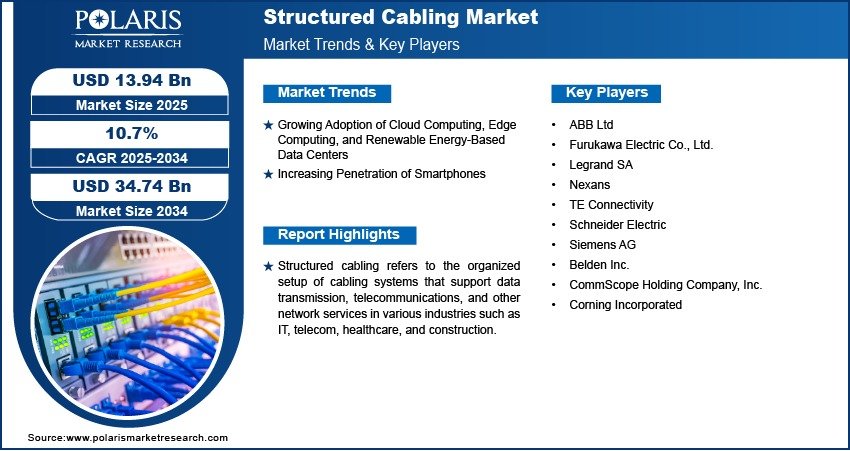Structured Cabling Market Expected to Grow to USD 34.74 Billion by 2034 | CAGR: 10.7%

Market Overview:
The global structured cabling market was valued at USD 12.62 billion in 2024. It is anticipated to witness robust growth, reaching USD 13.94 billion in 2025 and further expanding to USD 34.74 billion by 2034, at a CAGR of 10.7% during the forecast period (2025–2034). This expansion is driven by rising demand for high-speed connectivity, data centers, and advanced communication infrastructure globally. Structured cabling systems provide an organized, standardized approach to networking that supports high-performance data and voice transmission, making them an essential part of modern infrastructure across sectors.
Key Market Drivers & Barriers:
Several factors are fueling the growth of the structured cabling market:
-
Rapid data center expansion: Increasing investment in hyperscale and edge data centers is creating a higher need for efficient cabling systems.
-
Proliferation of IoT and smart devices: The growing adoption of IoT in industrial, commercial, and residential spaces demands faster and more reliable data transmission.
-
Advancements in networking technologies: Developments in 5G, Wi-Fi 6, and cloud computing are propelling the demand for structured cabling systems that can support higher bandwidth.
-
Growing digital transformation: Enterprises across the globe are modernizing their IT infrastructure, enhancing the need for structured cabling solutions.
-
Standardization and scalability: The ease of maintenance, cost-effectiveness, and future-proof design of structured cabling solutions are encouraging their adoption.
However, the market faces a few challenges, such as:
-
High initial installation cost: The upfront investment required for structured cabling systems may be a barrier for small enterprises.
-
Compatibility and integration issues: In older buildings or legacy systems, integrating new structured cabling systems can be technically challenging.
Latest Trends and Developments:
-
Adoption of fiber-optic cabling: There’s a noticeable shift toward fiber-optic cables due to their superior speed and reliability.
-
Emphasis on green and energy-efficient cabling solutions: Manufacturers are developing eco-friendly cabling systems to meet sustainability goals.
-
AI and automation in data centers: Intelligent cabling infrastructure is being deployed to support automated operations and AI workloads.
-
Smart building integration: Structured cabling is becoming a backbone for smart buildings, enabling seamless connectivity for automation systems.
-
Modular and scalable cabling systems: Innovations are focusing on modular systems that can be easily expanded based on changing requirements.
Market Size & Forecast:
|
Market Size Value in 2024 |
USD 12.62 billion |
|
Market Forecast Value in 2025 |
USD 13.94 billion |
|
Revenue Forecast by 2034 |
USD 34.74 billion |
|
CAGR |
10.7% from 2025 to 2034 |
Request for Free Sample:
https://www.polarismarketresearch.com/industry-analysis/structured-cabling-market/request-for-sample
Growth Opportunities and Future Potential:
As industries continue to embrace digital technologies, the structured cabling market stands to benefit significantly. Major opportunities lie in:
-
Expanding data center networks in Asia-Pacific and Middle East regions
-
Upgrades in legacy IT infrastructure across healthcare, finance, and education sectors
-
Deployment of cabling systems in 5G infrastructure and smart city projects
-
Integration with emerging tech like AR/VR, AI, and edge computing
With continued innovation and growing investment in networking infrastructure, the structured cabling market is set to achieve sustainable long-term growth.
Overview of Market Environment:
The structured cabling market operates in a dynamic environment shaped by rapid technological advancements and digital infrastructure investments. Key players are focused on offering end-to-end cabling solutions that ensure high performance, safety, and compliance with international standards. The market sees strong competition from global and regional vendors that offer differentiated solutions based on cable types, applications, and end-user industries. Additionally, government initiatives to promote smart cities and digital infrastructure are supporting the growth momentum across emerging economies.






